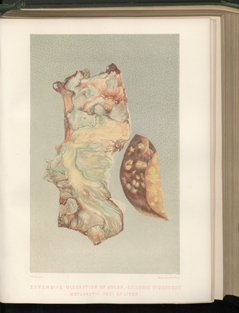Title: Snow, Daniel
Source text: The Medical and Surgical History of the War of the Rebellion. (1861-65.), Part 2, Volume 1 (Washington, DC: Government Printing Office, 1879), 448.
Civil War Washington ID: med.d1e41910
TEI/XML: med.d1e41910.xml
The chromo-plate facing page 452 exhibits one variety of diphtheritic ulcers. The following is an account of the case:
CASE 896.—Private Daniel Snow, company F, 2d New York heavy artillery; enlisted January 6, 1864, and is reported present with his company until after the first of May. On the muster-roll for May and June he is reported missing, and on that for July and August: "Absent; confined as a deserter by the provost-marshal." While in confinement he was attacked with dysentery, and became so sick that he was admitted to the field hospital of the 2d Army Corps at City Point, Virginia, September 6, 1864, where the diagnosis recorded was chronic dysentery. He appeared to be so ill that next day he was put on board the steamer Connecticut for transfer to general hospital. He was admitted to Douglas Hospital, Washington, D. C., September 9th, and the following particulars were communicated by Assistant Surgeon Wm. F. Norris, U. S. A.: The patient was much emaciated, and, in addition to the usual symptoms of the advanced stage of dysentery, had jaundice and frequent bilious vomiting. The abdomen was flat and tender, the skin cool, the pulse feeble. He had stupor, low delirium and involuntary stools. Died, September 17th. Autopsy: Body somewhat emaciated and intensely jaundiced. Organs of the thorax healthy. [The state of the small intestine is not recorded.] The large intestine was greatly thickened, contracted in calibre, and presented, from the cæcum to the anus, numerous large, irregular, ragged ulcers, most of which involved the muscular coat. The ulcers had sharp, abrupt, ragged edges. In the caput coli there was a perforation the size of a dime. Externally the peritonæum covering the intestine was roughened and adherent to the right lobe of the liver for an extent of two inches. There was but little fæcal matter in the large intestine, which contained a number of black and gray fibrin-like clots. The liver contained numerous yellow metastatic foci from a quarter to half an inch in diameter; these were mostly in the right lobe and in the course of the branches of the portal vein; many of them contained a small drop of yellow fluid in the centre, and consisted, as seen under the microscope, of disorganized liver tissue, granular matter and fat globules, but no pus. The other abdominal viscera were healthy. [Nos. 448 and 449, Medical Section, Army Medical Museum, are from this case.]
A portion of the descending colon and the liver from this case were brought to the Museumon the day of the autopsy, and water-color drawings of the appearances presented made by Mr. Hermann Faber; these are reunited in the chromo-plate. The very large ulcer shown near the middle of the piece, and parts of some of the others, laid bare the muscular coat, which was smooth and shining, while the bottoms of some of the ulcers only penetrated more or less deeply into the submucous connective tissue. The prevailing tint of the mucous membrane between the ulcers was yellowish, but it was streaked with bluish, gray and greenish tints, and in places brownish, reddish-brown or even bright red. Greenish or bluish neutral tints prevailed on the surface of the ulcers; their edges were rounded or bevelled, in but few places overhanging. The liver was dark brown externally, except where the metastatic foci described in the report of the autopsy were visible. Its cut section presented the nutmeg appearance in a marked manner and numbers of the metastatic foci. The description, given in the report, of the microscopical characters of these foci and of their relations to the portal vein was verified at the Museum. This case, then, is to be regarded as one of acute diphtheritic dysentery in which the sloughs had completely separated before death. The exact duration of the dysentery cannot be determined, but it probably set in some time after the deserter was captured by the provost-marshal, so that it is improbable that it commenced earlier than July, and it may not have done so until sometime in August. The metastatic foci in the liver were quite like those which occur in pyæmia, and I am disposed to regard them as consecutive upon the colon ulcers.
